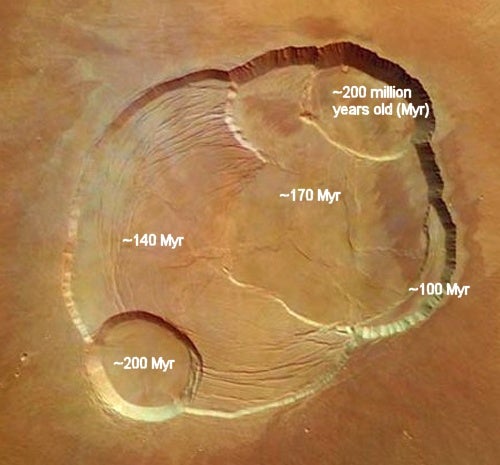Lava erupted on the flanks of the large martian volcano Olympus Mons perhaps only 2.4 million years ago, says a team of planetary scientists who examined sharply detailed images of five martian volcanoes in Tharsis. The images were taken by the Mars Express spacecraft’s High Resolution Stereo Camera (HRSC).
“These volcanoes are potentially still active today,” says Gerhard Neukum of Germany’s Freie Universität Berlin, team leader and the HRSC’s principal investigator. Moreover, team members say, glacial deposits 4 million years old ring the base of Olympus Mons. Their report appears in the December 23-30, 2004, issue of Nature.
To date the surfaces, the scientists counted craters on the five volcanoes and their immediate surroundings, then scaled the results to studies of Earth’s Moon. The most-uncratered, hence youngest, area seen — 2.4 million years old — lies on the western flank of Olympus Mons. (Besides the Mars Express photos, the area was also caught in frame E10-00828 by the orbiting Mars Global Surveyor’s camera.)
The researchers found that the calderas — the large collapse pits at the volcanoes’ summits — contain sections of varying ages. In the case of Olympus Mons, the ages range from 100 to 200 million years. The entire caldera floor of Arsia Mons is 130 million years old, while that of Ascraeus Mons has portions dating from 100 million to 3.5 billion years. Albor Tholus and Hecates Tholus show a roughly similar variety of ages.
According to the scientists, the caldera ages show the volcanoes have been active during the last few percent of martian history. This is essentially the present in geological terms. More intriguingly, most of the Olympus Mons caldera activity occurred within a 100-million-year period.
The fractured caldera floor shows puzzling features, however. Low regions are older, while high-standing ones are younger — the inverse of expectations. Looking at errors in the age-dating process, the team suggests all the caldera activity might have happened around 150 million years ago, with relatively minor differences in ages. Also, they say, some of the areas may be resurfaced by landslides or minor lava flows giving a younger appearance.
Surrounding Olympus Mons lie features resembling rock-covered glaciers and debris flows. By counting craters on these surfaces, the researchers dated the major flow lobes at 130 to 280 million years old, with lesser areas being 20 to 60 million years old. A few small locations dated to about 4 million years.
Running down from the scarp that circles Olympus Mons are rocky “tongues” of debris with no craters at all on them. “These are so young,” the team says, “that they cannot be reliably dated.”
The young ages arouse questions for some scientists. Mark Robinson of Northwestern University says, “The 2-million-year-old surface may be a lava flow that occurred then. However, it could also be a landslide that occurred 2 million years ago, or perhaps glacial modification.”
Sand dunes, Robinson explains by way of example, can bury a fresh lava flow and protect it from being cratered for tens of million of years. If unearthed, it will have the appearance of having flowed recently. Another pitfall, according to Robinson, concerns the martian cratering rate, a number he describes as very poorly known. “So caution’s the word,” he concludes.
Mars geologists generally agree the planet saw volcanic activity within the last 100 million years. And such activity, if it still continues in the geological present, might account for some or all of the methane observed by Mars Express. Because methane doesn’t linger in the martian environment, it needs replenishment. That could be the fingerprint of recent activity.










